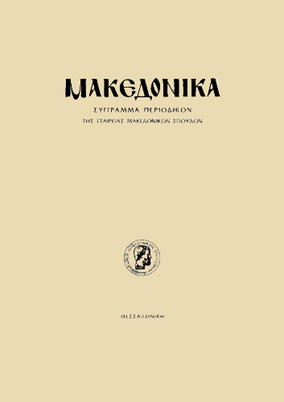Τα θυρόφυλλα του "Μακεδονικού τάφου" της Ευκαρπίας Σερρών : συμβολή στη μελέτη των θυρών των καταγείων ταφικών μνημείων
Part of : Μακεδονικά ; Vol.27, 1989, pages 209-222
Issue:
Pages:
209-222
Parallel Title:
The door panels of the «Macedonian tomb» of Eukarpia in Serres : A contribution in the study of the doors of the underground funerary monument
Section Title:
Articles
Abstract:
In this study we focus on the marble door found in 1968 at the village Eukarpia in Serres (PI. la) and which since that year is exposed in the Archaeological Collection of Serres (PI. 3). This door belongs to the plundered «Macedonian tomb», with one sepulchral chamber (dim. 3x2,25 m) (PI. 2a) located in the site called «Kartal Tepé» in the vicinity of the territorial frontiers of the villages Eukarpia and Nea Kerdylia. South of this tomb and in a distance of 2,5 km, in the location «Koukoura», the author had the chance to discover another similar tomb.The dimensions of the double monolithic panels of this door, which are preserved nearly intact, are: height: 2,10 m, width of the lower part 1,41 m — with a small narrowing on the part of 0,02 m—and thickness 0,065 m. As to their decoration, they imitate heavy wooden doors decorated with bronze ornaments (PI. 8a) which means that they consist of three, large transversal diazomas (PI. 4) sculptured in bas relief that take the place of planks (in ancient Greek «τα ζυγά») and of a vertical delicate cover-joint. Each one of the diazoma has a double row of twenty small convex discs (PI. 5a, b) in relief (diam. 0,05 m) set out one at a time and they simulate with large heads of nails («έφηλίδες»). On the cover-joint there is a single vertical row consisting of eleven nails (a total of 71 nails of the same type).Moreover, in each of the two uneven parts of the right panel that relate to each other 2 to 3, we discern two sculptured convex discs («άσπιδίσκαι») (diam. 0,15 m) (Pi. 5d, c) and a circural concavity (diam. 0,17 m) (PI. 6a) in the lower part of the left panel in which was probably fastened a head of a lion in fairly high relief.Finally, we try to analyse in detail the decoration, taking into account known typological and stylistic parallels. This analysis allows us to place chronologically our door to the late 4th or early 3d century B.C.
Subject:
Subject (LC):
Notes:
856:https://ejournals.epublishing.ekt.gr/index.php/makedonika/article/view/5662, DOI: https://doi.org/10.12681/makedonika.101
Electronic Resources:




